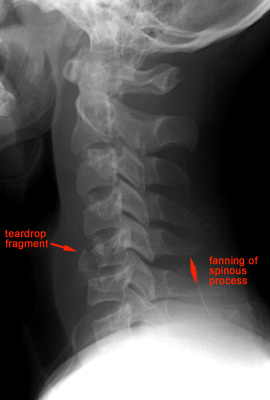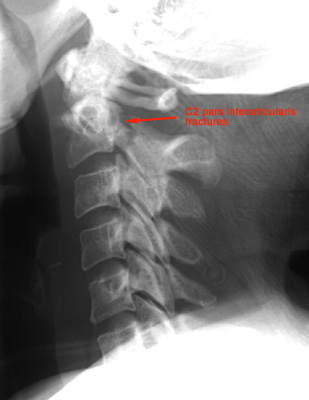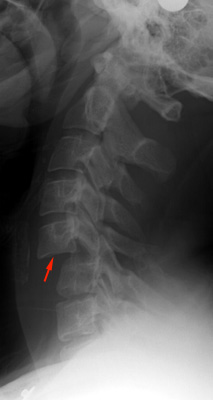Imaging of the Cervical Spine > Quiz Answers
Quiz Answers
![]()
alignment
Question 1: The indications for getting a cervical spine series include
all of the following except:
Question 2: Visualization of C7-T1 can often be enhanced by:
Question 3: Which one of the following line is not part of the parallel
lines alignment evaluation:
Question 4: After seeing this lateral view, the radiologist obtains a CT.
This is a:




Question 5: This 15 year old boy dove into a shallow pool head first and
complained of neck pain. The lateral view shows a:


1. Prevertebral swelling associated with anterior longitudinal ligament tear.
2. Teardrop fragment from anterior vertebral body avulsion fracture.
3. Posterior vertebral body subluxation into the spinal canal.
4. Spinal cord compression from vertebral body displacement.
5. Fracture of the spinous process.
Question 6: This patient arrived at the ED after a MVA. This lateral view
reveals a:


1. Prevertebral soft tissue swelling.
2. Avulsion of anterior inferior corner of C2 associated with rupture of the anterior longitudinal ligament.
3. Anterior dislocation of the C2 vertebral body.
4. Bilateral C2 pars interarticularis fractures.
Question 7: This lateral view shows a:


Question 8: This lateral view shows a:


1. Complete anterior dislocation of affected vertebral body by half or more of the vertebral body AP diameter.
2. Disruption of the posterior ligament complex and the anterior longitudinal ligament.
3. "Bow tie" or " bat wing" appearance of the locked facets.
Question 9: Clay Shoveler's fracture is caused by:
Question 10: Jefferson fracture is treated by:
